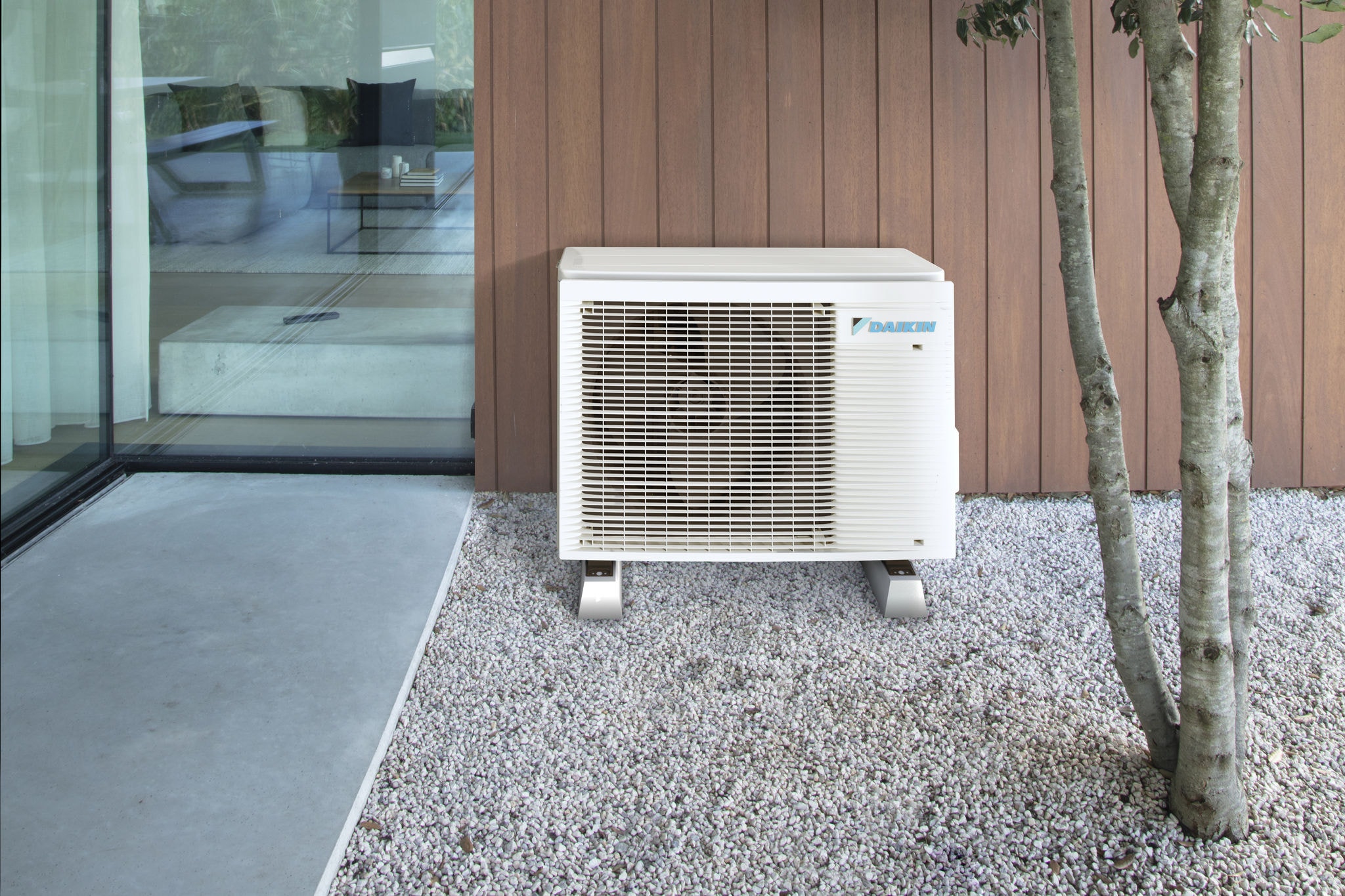How air conditioning works (and why heat pump systems make a difference)
Learn about how it works, its components, and why a heat pump system can transform your comfort and energy consumption.

When the heat sets in and we're relaxing on the sofa, enjoying the cool air from the air conditioning unit on the wall, a question often comes to mind: how does air conditioning work? Even though we use it every day, few people truly understand the intricacies of this everyday comfort. In this article, we will unravel the secrets of how it operates, explore its main components, discover the role of the heat pump system, and explain why Daikin supports this technology.
The parts that make up an air conditioner
To understand how air conditioning works, it's important to first know its main components. Although there are various types of units, they all share key components that work together to regulate room temperature.
Outdoor unit
This is the unit that is installed outside the building, such as on a balcony or an exterior wall. Inside it are the compressor, the condenser, and a fan. Its main function is to expel the heat extracted from inside to the outside.

Indoor unit
This unit is located inside the home or premises. It houses the evaporator and a fan that distributes the cooled (or heated, if the unit includes a heat pump) air into the indoor environment.
Compressor
Considered the heart of the system, the compressor circulates the refrigerant throughout the circuit. It compresses the gas to increase its pressure and temperature before sending it to the condenser.
Condenser
This is where the hot refrigerant releases the heat it has previously absorbed. As it cools down, it changes from a gaseous to a liquid state, yielding that heat to the outside air.
Expansion valve
This component regulates the flow of refrigerant to the evaporator. As it passes through, the refrigerant expands and cools rapidly, preparing to absorb heat.
Evaporator
At this stage, the refrigerant, now cold, absorbs heat from the indoor air. Absorbing this heat means the environment is cooled. The cooled air is then introduced into the room by a fan.
Refrigerant
This is the fluid that circulates throughout the system. It can easily absorb and release heat, allowing it to transfer thermal energy from inside to outside in cooling mode, or vice versa in heating mode.
The operating cycle: how a space is cooled (or heated)
Now that we understand the key components, it's easier to see how climate control is achieved. The operation of an air conditioner is based on a cycle that repeats continuously while the unit is running:
The refrigerant enters the evaporator at low pressure and temperature.
As it passes through the evaporator, it absorbs heat from the air in the room, cooling the environment.
The refrigerant, now warmer, moves to the compressor, where its pressure and temperature increase.
Next, it reaches the condenser, where it releases heat to the outside and turns into a liquid.
The cooled refrigerant then passes through the expansion valve, which reduces its pressure and cools it further.
It then returns to the evaporator to begin the cycle again.
This process ensures a comfortable temperature is constantly and efficiently maintained.
How does an air-to-air heat pump work?
The heat pump system is a technology that harnesses the thermal energy in the outside air to regulate indoor temperatures. Rather than generate heat or cold from scratch, it transfers energy from one place to another, using a renewable and free source: the air.
In the case of air-to-air heat pumps, such as those produced by Daikin, the system uses a heat pump. This allows the unit to operate both in cooling and heat modes, reversing the cycle described above.
Its main advantage is energy efficiency: it can generate up to 4 kWh of thermal energy for every kWh of electricity consumed. This translates to lower energy consumption and a more sustainable solution for climate control in homes and buildings. But let’s take a closer look at the benefits of choosing these systems:
Benefits of heat pump systems in air conditioning:
1. High energy efficiency
As mentioned, heat pump systems can produce up to four times more thermal energy than the electricity they consume. This efficiency leads to lower energy costs and, consequently, a smaller electricity bill.
2. All-in-one climate control
A single system allows cooling in summer and heating in winter, eliminating the need to install separate units for each function.
3. Renewable energy
The heat pump system harnesses a clean, inexhaustible energy source: the heat present in the air. This makes it a more environmentally friendly solution compared to other conventional systems.
4. Lower emissions
By using less electricity and avoiding fossil fuels, heat pump systems play their part in reducing CO₂ emissions, helping to meet sustainability targets.
5. Versatile installation
Air-to-air heat pump systems, such as those manufactured by Daikin, can be installed in detached houses, flats, and buildings, adapting to various spaces and needs.

Do you want to install a heat pump system in your home? Choose a Daikin air conditioner
At Daikin, we have long committed to using heat pump technology as the foundation of our climate control solutions. All our home air conditioners operate with this technology because we firmly believe in its ability to deliver maximum comfort with minimal environmental impact.
From the most compact split systems to multi-split solutions and ducted units, all our products feature heat pumps based on this technology. This means you are using renewable energy from the very first minute, whether cooling your living room in August or heating your bedroom in January.
Inverter technology: efficiency in every cycle
Another key element in the performance of a modern air conditioner is Inverter technology. Unlike traditional units that operate at "all or nothing", an air conditioner with Inverter technology continuously regulates compressor speed.
What does this mean? That the system adapts its operation in line with the demand for air conditioning. It does not switch off when the desired temperature is reached; instead, it reduces its power in order to maintain stability, avoiding consumption peaks and enhancing comfort.
Benefits of the Inverter system:
Up to 30% energy savings.
Greater durability
Less noise and vibration
Constant temperature without fluctuations
All Daikin air conditioners are fitted with Inverter technology, so the combination of heat pump + Inverter is a guarantee of efficiency and comfort for your home.
Much more than cooling: smart, sustainable comfort
Understanding how air conditioning works is the first step in appreciating what a good climate control system really offers. At Daikin, we strive to make that experience as efficient, intelligent, and sustainable as possible.
In addition to heat pump systems and Inverter technology, our systems feature scheduling, presence and motion sensors, and Internet connectivity, enabling you to control your home’s temperature from your mobile device.
Because comfort today is no longer just a matter of temperature but also of efficiency, sustainability, and technology.
In summary, if you've ever wondered how air conditioning operates, then you now know that its effectiveness relies on a thermal heat exchange cycle, supported by components like the compressor, evaporator, and condenser. In Daikin’s case, all our units are heat pump systems that harness the energy in the air to provide sustainable climate control. And, thanks to Inverter technology, this efficiency is further enhanced, ensuring consistent optimal performance.
The next time you turn on your air conditioner, you will know that it operates with cutting-edge technology, allowing you to enjoy optimal comfort while maintaining savings and respecting the planet.